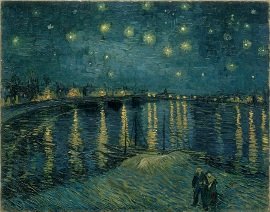Van Gogh and the colours of the night
dal 12/2/2009 al 6/6/2009
Segnalato da
Vincent Van Gogh
Eugene Boch
Charles Daubigny
Jules Dupre'
Paul Gauguin
Joachim Pissarro
Sjraar van Heugten
12/2/2009
Van Gogh and the colours of the night
Van Gogh Museum, Amsterdam
The show is devoted exclusively to the evening and nighttime scenes by Vincent van Gogh. The works on show are both magnificent and intimate, and the presentation as a whole will aim to convey these two facets as well. The painting represents one of Van Gogh's most radical stylistic experiments and has a strong expressive force of almost romantic and religious import. Altogether the exhibition comprises 32 paintings, 19 works on paper and five sketches from Van Gogh's letters.

From 13 February to 7 June 2009 the Van Gogh Museum in Amsterdam will be staging the exhibition Van Gogh and the colours of the night. This is the first show to be devoted exclusively to the evening and nighttime scenes by Vincent van Gogh (1853-1890), with the Van Gogh Museum being the only European venue for this unique exhibition concept. Van Gogh imbued his twilight and nocturnal scenes with a wealth of associations, heartfelt emotions and a poetic sense of ambience.
The works on show are both magnificent and intimate, and the presentation as a whole will aim to convey these two facets as well. Many of the ‘night works’ included in the exhibition have long acquired iconic status -- such as the famous canvas The starry night from New York’s Museum of Modern Art (MoMA), which will be on show in the Van Gogh Museum for the first time since 1990. The painting represents one of Van Gogh’s most radical stylistic experiments and has a strong expressive force of almost romantic and religious import. Altogether the exhibition comprises 32 paintings, 19 works on paper and five sketches from Van Gogh´s letters. KPN is main sponsor of Van Gogh and the colours of the night.
Twilight and the night is a prominent theme throughout Van Gogh’s oeuvre. Van Gogh viewed the evening and the night as a time for reflection and creativity, a time particularly suitable for mulling over the day’s events. For this reason he liked to work during the dark hours, for they gave him energy and inspiration. Arranged around the themes Landscapes at twilight, Peasant life at evening – ‘Les Paysans chez eux’, The voice of the wheat and Poetry of the night, the exhibition shows how Van Gogh immortalized the twilight and the night on paper and on canvas. In addition, in Van Gogh and the pictorial tradition visitors can view works by masters of the Barbizon School (Daubigny, Corot, Millet). Several masterpieces by avant-garde contemporaries of Van Gogh such as Seurat and Anquetin demonstrate that Van Gogh was not alone in his love for the effects of the twilight and night.
With his Landscapes at twilight Van Gogh was linking up with a longstanding pictorial tradition of evening and nighttime scenes that was well-known to him. The crepuscular landscape was well-represented within the Barbizon School by painters such as Charles Daubigny and Jules Dupré, whom Van Gogh admired greatly. The exhibition shows how Van Gogh initially sought to connect with this tradition, but later contributed his own modern interpretation of the genre.
Peasant life at evening – ‘Les Paysans chez eux’ refers to Van Gogh’s studies of peasant farmers in Nuenen, a village in the southern Dutch province of Brabant. Here he painted his first masterpiece The potato eaters, a painting that should be viewed and understood in the context of Rembrandt’s nighttime scenes, which had acted as Van Gogh’s source of inspiration. Closely interwoven with this is the motif of the peasant dwellings, simple but picturesque buildings with thatched roofs that Van Gogh tenderly dubbed ‘menschennesten’(‘human nests’) because he saw them as a safe haven for their poverty-stricken inhabitants.
The voice of the wheat, a quotation Van Gogh borrowed from a poem by Jules Breton, reflects the artist’s fascination with the sowing and harvesting of the grain and the wheat sheaves in the fields, which to him seemed symbols of eternity. In this exhibition three masterpieces from 1888 have come together again for the first time since 1984: three versions of the sower, from the collections of, respectively, the Kröller-Müller Museum, the Foundation E.G. Bührle Collection and the Van Gogh Museum. Van Gogh positioned his sowers against a setting sun at the end of the day, a subtle reference to the never-ending cycle of life.
Poetry of the night shows Van Gogh’s famous starry nights painted in Arles (Musée d’Orsay) and Saint-Rémy (MoMA). In the open air, under the overarching sky, Van Gogh perceived the formidable, unstoppable forces of nature, evoking a sense of the eternity of being in which man could find solace in the face of a cruel and hard existence. The poetic feelings the painter harboured for the hours of the night are also expressed in the portraits he painted of his friends Paul Gauguin and Eugène Boch, the latter pictured against a background of stars in order to present him as poet.
Collaboration Van Gogh Museum with The Museum of Modern Art (MoMA)
Van Gogh and the colours of the night is the first collaborative project that the Van Gogh Museum has undertaken with New York’s Museum of Modern Art and is organized by Joachim Pissarro (Adjunct Curator of MoMA, Bershad Professor of Art History and Director of the Hunter College Galleries) and Sjraar van Heugten (Head of Collections of the Van Gogh Museum). The exhibition is on show at The Museum of Modern Art in New York until 5 January 2009.
Van Gogh Museum
Paulus Potterstraat, 7 Amsterdam



